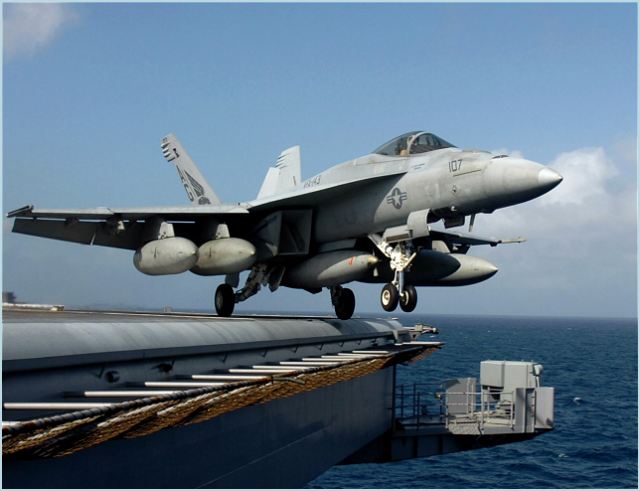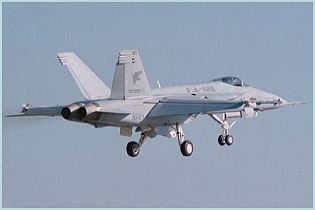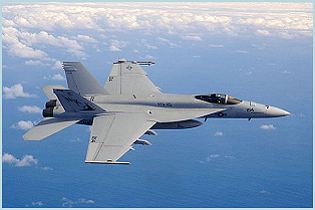F/A-18 Super Hornet
| a | ||||||||||||||||||||||
|
F/A-18 E/F Super Hornet Multirole fighter aircraft
|
||||||||||||||||||||||
|
|
||||||||||||||||||||||
|
The combat-proven F/A-18E/F Super Hornet delivers cutting-edge next generation multi-role strike fighter capability that is available today, outdistancing current and emerging threats well into the future. The Super Hornet has the capability, flexibility and performance necessary to modernize the air or naval aviation forces of any country. Built by the industry team of Boeing, Northrop Grumman, GE Aircraft Engines, Raytheon and more than 1,900 suppliers nationwide, the Super Hornet provides the warfighter with today’s newest advances in multimission capability and growth for decades to come in missions, roles and technology. The Super Hornet’s suite of integrated and networked systems provides enhanced interoperability and support for ground forces as well as the overall force commander. The Super Hornet entered combat on its maiden voyage in 2002 and remains combat deployed today. |
||||||||||||||||||||||
| Variants | ||||||||||||||||||||||
| - F/A-18E Super Hornet: single seat variant. - F/A-18F Super Hornet: two-seat variant. - EA-18G Growler: electronic warfare aircraft, a specialized version of the two-seat F/A-18F Super Hornet. |
||||||||||||||||||||||
|
|
||||||||||||||||||||||
| Technical Data | ||||||||||||||||||||||
| Back menu | ||||||||||||||||||||||
| Design | ||||||||||||||||||||||
|
The F/A-18E/F was designed around a balanced approach to survivability, incorporating low observability with internal integrated countermeasures, and high crew situational awareness to provide first-day-of-the-war capability. The next-generation aerodynamic design of the Super Hornet Block II enhances combat effectiveness, safety and training by offering unlimited angle of attack maneuvering, extreme maneuverability and exceptional combat agility.
The Super Hornet is largely a new aircraft. It is about 20 percent larger, 3,200 kg heavier at empty weight, and 6,800 kg heavier at maximum weight than the original Hornet. The Super Hornet carries 33 percent more internal fuel, increasing mission range by 41 percent and endurance by 50 percent over the "Legacy" Hornet. The empty weight of the Super Hornet is about 5,000 kg less than that of the F-14 Tomcat which it replaced, while approaching, but not matching, the F-14's payload and range. |
||||||||||||||||||||||
| Avionic | ||||||||||||||||||||||
|
A comprehensive spiral development design concept – including the addition of the APG-79 active electronically scanned array (AESA) radar – offers continuously improving overall mission capability and supportability. Integrating the APG-79 AESA radar, Advanced Targeting Forward Looking Infrared (ATFLIR) system, Joint Helmet Mounted Cueing System (JHMCS), Multifunctional Information Distribution System (MIDS), advanced high capacity computer system, and state-of-the-art cockpit provides the warfighter with intuitive situational awareness. |
||||||||||||||||||||||
| Propulsion | ||||||||||||||||||||||
|
Two General Electric F414-GE-400 engines power the Super Hornet, producing a combined 44,000 pounds of thrust. Increased airflow to the engine is provided through the Super Hornet’s large, distinctively shaped inlets. A full authority digital electronics control (FADEC) allows for unrestricted engine response in any phase of flight.
|
||||||||||||||||||||||
| Armament | ||||||||||||||||||||||
|
With a total of 11 weapons stations, the Super Hornet gives warfighters extraordinary payload flexibility by carrying a mixed load of air-to-air and air-to-ground ordnance. A typical basic loadout for a self-escort strike mission starts with an advanced infrared targeting pod, one AIM-120 AMRAAM, two AIM-9 Sidewinder missiles, a 20mm cannon and an external fuel tank. This leaves six under-wing weapon stations available to carry a variety of weapons and other stores.
The FA-18 Super Hornet is armed with 1× 20 mm (0.787 in) M61 Vulcan nose mounted gatling gun, 578 rounds. Eleven hardpoints are available on the F-18 with 2× wingtips, 6× under-wing, and 3× under-fuselage with a capacity of 8,050 kg external fuel and ordnance. Air-to air Missiles: 4× AIM-9 Sidewinder or 4× AIM-120 AMRAAM, and 2× AIM-7 Sparrow or additional 2× AIM-120 AMRAAM. Air-to-surface missiles: AGM-65 Maverick, Standoff Land Attack Missile (SLAM-ER), AGM-88 HARM Anti-radiation missile or AGM-154 Joint Standoff Weapon (JSOW). |
||||||||||||||||||||||
| Specifications | ||||||||||||||||||||||
|
||||||||||||||||||||||
 |
||||||||||||||||||||||
|
||||||||||||||||||||||
| Back menu | ||||||||||||||||||||||
































